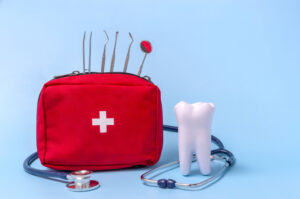Dental emergencies can occur at any time, often leaving you in pain and unsure of what steps to take next. Whether it’s a sudden toothache, a broken tooth, or a knocked-out tooth, understanding what to expect during a dental emergency can help you manage the situation effectively and reduce anxiety. This guide provides a clear, step-by-step overview of what you can anticipate when facing a dental crisis, ensuring you remain calm and informed throughout the process.
Immediate Actions Before Seeing a Dentist
When a dental emergency strikes, your first priority is to minimise pain and prevent further damage until you can receive professional help. Here are the immediate steps you should take:
- Stay Calm: Panic can worsen the situation. Take deep breaths to remain as calm as possible.
- Control Bleeding: If you’re experiencing bleeding, apply a clean gauze pad to the affected area and apply gentle pressure for about 10-15 minutes until the bleeding stops.
- Manage Pain and Swelling: Over-the-counter pain relievers such as ibuprofen or paracetamol can help reduce pain and inflammation. Applying a cold pack to the outside of your cheek near the affected area can also help minimise swelling.
- Preserve a Knocked-Out Tooth:
- Handle with Care: If a tooth is knocked out, pick it up by the crown (the visible part), avoiding contact with the root.
- Rinse Gently: Rinse the tooth with water if it’s dirty, but do not scrub or remove any attached tissue.
- Reimplantation: If possible, try to place the tooth back into the socket and hold it in place with gentle pressure.
- Storage: If reinsertion isn’t feasible, store the tooth in milk or saline solution and seek immediate dental care.
- Protect Exposed Roots: For teeth with exposed roots, cover them with a piece of sugar-free gum or dental wax to protect them until you can reach a dentist.
- Remove Debris: Gently remove any loose fragments from chipped or broken teeth and rinse your mouth with water to clean the area.

What to Expect When You Arrive at the Dental Clinic
Arriving at the dental clinic during an emergency can be stressful, but knowing what to expect in emergency dentistry can help ease your anxiety. Here’s a step-by-step overview of the process:
- Initial Assessment:
- Triage: The dental team will perform a quick evaluation to determine the severity of your emergency and prioritise treatment based on urgency.
- Medical History: You may be asked about your medical history and any medications you’re taking to ensure safe and effective treatment.
- Pain Management:
- Local Anesthesia: To alleviate pain, the dentist may administer a local anesthetic to numb the affected area.
- Medication: In cases of infection or severe pain, additional medications such as antibiotics or stronger pain relievers might be prescribed.
- Diagnosis and Treatment Planning:
- Examination: The dentist will thoroughly examine your teeth and gums, possibly using X-rays to get a detailed view of the issue.
- Treatment Options: Based on the diagnosis, the dentist will outline the necessary procedures to address the emergency. This could range from repairing a chipped tooth to performing a root canal or reimplanting a knocked-out tooth.
- Restoration Procedures:
- Repairs: For chipped or broken teeth, procedures like dental bonding, veneers, or crowns may be used to restore the tooth’s appearance and functionality.
- Implants: If a tooth is knocked out and reimplantation is possible, the dentist will carefully place the tooth back into the socket and secure it.
- Extractions: Severely damaged or decayed teeth may need to be extracted to prevent further complications.
- Follow-Up Care:
- Appointments: Depending on the treatment, follow-up appointments may be scheduled to monitor healing and ensure the effectiveness of the procedure.
- Instructions: You’ll receive post-treatment care instructions, such as how to care for the treated area, what foods to avoid, and signs of potential complications to watch for.
Aftercare and Recovery
Proper aftercare is essential for a smooth recovery and to prevent further issues. Here’s what you can expect:
- Pain Management: Continue taking prescribed or over-the-counter pain relievers as directed by your dentist. Avoid very hot or cold foods and beverages if you’ve had a tooth extracted or a filling replaced.
- Oral Hygiene: Maintain good oral hygiene by brushing and flossing gently around the treated area. Your dentist may recommend using a special mouthwash to aid in healing.
- Dietary Adjustments: Stick to soft foods and avoid chewing on the side of your mouth where the emergency occurred until it has fully healed.
- Monitoring Healing: Pay attention to how the treated area heals. If you experience excessive pain, swelling, or any unusual symptoms, contact your dentist immediately.
Conclusion
Dental emergencies can be overwhelming, but being prepared and knowing what to expect can significantly improve how you handle these situations. By taking immediate steps to manage the emergency, understanding the process at the dental clinic, and following proper aftercare, you can protect your oral health and maintain a confident smile. Remember, your dentist is there to help you through any urgent dental needs, so don’t hesitate to reach out when necessary.


